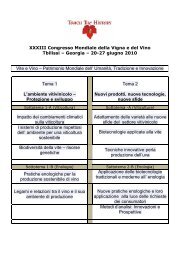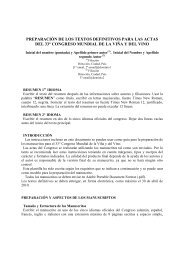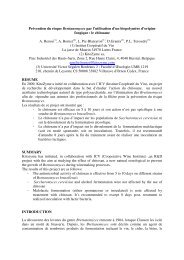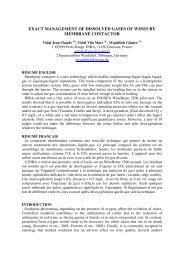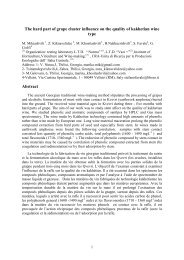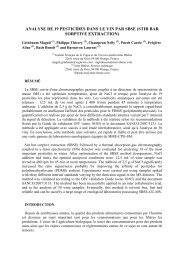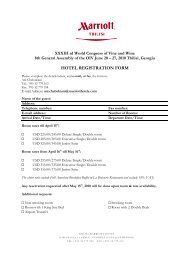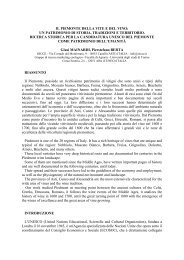Some Biological Activities of Vine Stilbens and New ... - Oiv2010.ge
Some Biological Activities of Vine Stilbens and New ... - Oiv2010.ge
Some Biological Activities of Vine Stilbens and New ... - Oiv2010.ge
You also want an ePaper? Increase the reach of your titles
YUMPU automatically turns print PDFs into web optimized ePapers that Google loves.
Trans-resveratrol <strong>and</strong> ε-viniferin in red Georgian wines<br />
M. Bezhuashvili, M. Kokhtashvili, T. Kobaidze, N. Vepkhishvili<br />
Institute <strong>of</strong> Horticulture, Viticulture <strong>and</strong> Oenology <strong>of</strong> Georgia<br />
#6, Marshal Gelovani St., 0159, Tbilisi, Georgia<br />
mbezhuashvili@yahoo.com<br />
ABSTRACT<br />
At present, out <strong>of</strong> the rich spectrum <strong>of</strong> the phenol substances <strong>of</strong> Georgian red wines, stilbens<br />
are not thoroughly studied. In 1991-1994, we isolated <strong>and</strong> identified from Rkatsiteli vine<br />
species trans-resveratrol, ε-viniferin <strong>and</strong> two Tetramers <strong>of</strong> resveratrol. The dependence <strong>of</strong><br />
trans-resveratrol concentration in the red Georgian wines on the vine species <strong>and</strong> wine type<br />
has been identified. Of naturally semi-sweet, semi-sweet, dry <strong>and</strong> naturally cleared fortified<br />
wines, trans-resveratrol was found in the greatest concentrations in the fortified wines. 0,78-<br />
3,20 mg/l (in Saperavi); 0,69-2,62 mg/l (Otskhanuri Sapere); 0,65-2,87mg/l (Cabernet<br />
Sauvignon); 0,47-1,92 mg/l (Tavkveri). ε-viniferin in self-cleared dry bulk wine <strong>of</strong> Saperavi<br />
<strong>and</strong> Cabernet Sauvignon amounts to 0,98 mg/l <strong>and</strong> 0,40 mg/l, respectively.<br />
Key words: Red wine, Trans-resveratrol, ε-viniferin.<br />
RESUME<br />
A nos jours parmi le spectre riche de produits phénoliques des vins rouges géorgiens les<br />
stilbènes ne sont pas encore étudiés complètement. En 1991-1994 il a été distingué et identifié<br />
du cépage Rkatsitéli le trans-resvératrol, la ε-viniférine et deux tetramètres de resvératrol. Il<br />
est découvert que dans les vins rouges géorgiens le taux de concentration de trans-resvératrol<br />
dépend des cépages de vignes et des types de vins. Le taux de concentration est élevé dans les<br />
vins naturellement demi-sucré, demi-sucré, sec et les vins fortifiés filtrés naturellement.<br />
Sapéravi 0,78 – 3,20 mg/L ; Otskhanouri Sapéré 0,69 – 2,62 mg/L ; Le taux de ε-viniférine<br />
dans les vins fins de Sapéravi et Cabernet Sauvignon filtrés naturellement, secs est : 0,98<br />
mg/L et 0,40 mg/L.<br />
Mots clés : Vin rouge, Trans-resvératrol, ε-viniférine.<br />
INTRODUCTION. Georgia is the homel<strong>and</strong> <strong>of</strong> vine <strong>and</strong> wine. The gene pool <strong>of</strong> Georgian<br />
vines including approximately 525 unique species <strong>of</strong> white <strong>and</strong> versicolored vine has been<br />
tried by the Georgians for centuries. The diversified technologies to produce different types <strong>of</strong><br />
wine developed as a result <strong>of</strong> the rich experience, have been shifted to one generation to<br />
another <strong>and</strong> as time went, they were perfected <strong>and</strong> new technologies were developed. In this<br />
respect, the merit <strong>of</strong> Georgian scientists as the foundation <strong>of</strong> Georgian viticulture <strong>and</strong><br />
winemaking is worth mentioning. The curative properties <strong>of</strong> grape <strong>and</strong> wine always attracted<br />
a great deal <strong>of</strong> attention <strong>of</strong> different scientific branches. This is particularly true with red<br />
Georgian wines known for their curative properties from the ancient times <strong>and</strong> are a panacea<br />
in Georgian folk medicine, particularly, the bread soaked in red wine. The scientific progress<br />
allowed thoroughly explaining the close connection between the useful properties <strong>of</strong> red wine<br />
<strong>and</strong> its rich chemical content.<br />
1
The search for the fundamentals <strong>of</strong> the phenomenon <strong>of</strong> the “French paradox” was followed by<br />
the intense study <strong>of</strong> the content <strong>of</strong> red wines on an international scale. Numerous experiments<br />
have demonstrated the leading role <strong>of</strong> biologically active phenol substances in the formation<br />
<strong>of</strong> the curative <strong>and</strong> nutritive value <strong>of</strong> red wines. Identification <strong>of</strong> stilbens <strong>and</strong> particularly<br />
resveratrol, which is their monomer representative, <strong>and</strong> their determination in red <strong>and</strong> pink<br />
wines made <strong>of</strong> different vine species in a range <strong>of</strong> countries is associated with these studies.<br />
(Waterhouse,1993; Roggero, Archier, 1994; .Lamuela-Raventos et al.,1995; Romero-<br />
Perez et al.,1996; Lamuela-Rawentos, Waterhouse, 1993; Lamikarna, et al.,1996).The<br />
further studies, besides resveratrol, identified its derivatives: piceids, dimmers: ε-viniferin <strong>and</strong><br />
δ-viniferin; trimer α-viniferin, etc. as well as other stilbens. (Ribeiro de Lima et al.,1999;<br />
Guebailia et al., 2006). Out <strong>of</strong> resveratrol isomers, it is red wines with the higher content <strong>of</strong><br />
trans-resveratrol if compared to cis-resveratrol. At the same time, trans-resveratrol is<br />
biologically more active than cis-resveratrol. The established diversified biological activities<br />
<strong>of</strong> stilbens greatly make for the positive effect <strong>of</strong> red wines against cardiovascular, cancerous,<br />
thrombotic <strong>and</strong> other diseases( Blond et al., 1995; Klatsky et al.,1997; Yang et al., 1997;<br />
Szmitko, Verma, 2005; Balestrieri et al., 2008).<br />
.<br />
We started to study stilbens in 1991-1994, <strong>and</strong> individually isolated <strong>and</strong> identified transresveratrol,<br />
ε-viniferin <strong>and</strong> two tetramers <strong>of</strong> resveratrol from 1-year-old Rkatsiteli (Vitis<br />
vinifera L.) vine shoot (Bezhuashvili et al., 1991; Bezhuashvili et al., 1997; Bezhuashvili,<br />
1994).<br />
Trans-resveratrol<br />
ε-viniferin<br />
2
Tetramer-I<br />
Tetramer-II<br />
Then, we continued studying them in red Georgian wines. It should be noted that a<br />
Georgian scientist Durmishidze S. <strong>and</strong> his colleagues have made a great contribution to the<br />
study <strong>of</strong> the diversified spectrum <strong>of</strong> phenol compounds <strong>of</strong> the vine species spread in Georgia<br />
(Durmishidze, Khachidze, 1979; 1985). Out <strong>of</strong> phenol compounds, proantocyanidines<br />
(oligomeric <strong>and</strong> polymeric), phenolic acids, anthocyanins, catechines, flavonols, etc. have<br />
been identified. Saperavi species growing in different regions <strong>of</strong> Kakheti have been studied<br />
by us, <strong>and</strong> we identified the differences between the chemical compositions <strong>of</strong> bulk wines.<br />
The property <strong>of</strong> an early (9-month-long) stabilization <strong>of</strong> Saperavi growing in Khashmi has<br />
been identified in Kakheti Region. This property is demonstrated by the wine changing for the<br />
coloured complex <strong>of</strong> anthocyanins by preserving its intense ruby color, with the colouring<br />
intensity coefficient T
engaged in an intense study in the direction <strong>of</strong> “Wine <strong>and</strong> health” to identify specifically the<br />
stilben spectrum in red Georgian wines. At present, we have identified <strong>and</strong> determined<br />
resveratrol dimmer ε-viniferin.<br />
MATERIALS AND METHODS. We used the different types <strong>of</strong> naturally cleared red<br />
wines made with Saperavi, Otskhanuri Sapere, Cabernet Sauvignon <strong>and</strong> Tavkveri species as<br />
the objects <strong>of</strong> the study, in particular, dry table, naturally semi-sweet, semi-sweet <strong>and</strong> fortified<br />
wines. For qualitative <strong>and</strong> quantitative analyses <strong>of</strong> trans-resveratrol, we extracted the wines in<br />
advance with ethyl acetate <strong>and</strong> used the gained fraction for analyses. We used thin-layer<br />
chromatography with silufol plates (20 cm x 20 cm), system: chlor<strong>of</strong>orm : methanol (80:20)<br />
<strong>and</strong> denitrated sulfanilic acid as a developer. We defined the quantity <strong>of</strong> trans-resveratrol by<br />
high-efficiency liquid chromatography in terms <strong>of</strong> gradient. The column <strong>of</strong> Nucleosil C 18 ,<br />
eluent A: water + H3PO4; eluent B: acetonitrile+H3PO4, pH=3,5-4,0. Out <strong>of</strong> naturally cleared<br />
dry table bulk wines made with the 2008 harvest <strong>of</strong> Saperavi <strong>and</strong> Cabernet Sauvignon, we<br />
isolated the total stilbens with further treatment <strong>of</strong> their ethyl acetate fractions (Ribeiro de<br />
Lima et al., 1999). We analyzed the gained fraction by high-efficiency liquid chromatography<br />
in terms <strong>of</strong> gradient (the chromatograph made by “Varian”); UV detector/visible spectrum,<br />
column – Microsorb 100 C18, 250X4,6 LxId (mm); 5µm – Particle Size. Eluent A: TF<br />
(trifluoroacetic acid) 0,025% water solution; eluent B: AСN/AA, 80/20 (v/v); (Guebailia, et<br />
al., 2006).<br />
RESULTS AND DISCUSSION. The gained results demonstrate that the concentration <strong>of</strong><br />
trans-resveratrol in bulk wines depends on different factors, one <strong>of</strong> which is the generic factor.<br />
In this respect, Saperavi <strong>and</strong> Otskhanuri Sapere are the most obvious examples. The<br />
concentration <strong>of</strong> trans-resveratrol in bulk wines also changes according to the sugar content <strong>of</strong><br />
the must. In particular, within the range <strong>of</strong> 19,1-26,0%, the content <strong>of</strong> trans-resveratrol in the<br />
red wines made <strong>of</strong> Saperavi with different sugar contents changes from 1,69 mg/l to 2,87<br />
mg/l; for Otskhanuri Sapere (with the sugar content <strong>of</strong> 19,2%-22,4%), it is 1,25 mg/l 1,95<br />
mg/l <strong>and</strong> for Cabernet Sauvignon (with the sugar content <strong>of</strong> 19,3%-22,7%), it is 1,15 mg/l to<br />
2,25 mg/l. At this point, in addition to the generic factor, the factor <strong>of</strong> alcohol-content <strong>of</strong> the<br />
pomace fermented is obviously seen. As for the wine type, it is seen as the factor making the<br />
wines made with the same grape species significantly different from one another with their<br />
concentration <strong>of</strong> trans-resveratrol. This is proved by the diagram in “Fig. 1”.<br />
“Fig. 1”. Change <strong>of</strong> the concentration <strong>of</strong> trans-resveratrol according to the types <strong>of</strong> wine.<br />
I – naturally semi-sweet, II – semi-sweet, III – dry, IV – fortified.<br />
Among the naturally semi-sweet, semi-sweet, dry <strong>and</strong> fortified wines, the concentration <strong>of</strong><br />
trans-resveratrol is the highest in the fortified wine <strong>and</strong> is the least in the naturally semi-sweet<br />
wine. Besides the above-mentioned factors, temperature <strong>and</strong> squeezing <strong>and</strong> mixing <strong>of</strong><br />
4
fermented pomace were also identified as the factors affecting the quantity <strong>of</strong> trans-resveratrol<br />
in bulk wines (Kokhtashvili, Bezhuashvili; 1998, Kokhtashvili et al. 2002; Kokhtashvili,<br />
2006).<br />
The data <strong>of</strong> thin-layer <strong>and</strong> liquid chromatographs <strong>of</strong> the total stilben fraction gained from<br />
dry table bulk wines made <strong>of</strong> Saperavi <strong>and</strong> Cabernet Sauvignon prove their variety. The<br />
stilben spectrum, besides trans-resveratrol <strong>and</strong> ε-viniferin, is presented by some other stilbens<br />
(“Fig. 2”). The concentration <strong>of</strong> ε-viniferin in Saperavi bulk wines is 0.98 mg/l <strong>and</strong> is 0.40<br />
mg/l in Cabernet Sauvignon. At present, an intense research is carried out to study the stilben<br />
spectrum in red Georgian wines.<br />
“Fig. 2”. Liquid chromatogram <strong>of</strong> stilben fractions gained from dry table bulk wines <strong>of</strong><br />
Saperavi.<br />
CONCLUSIONS. The content <strong>of</strong> biologically active high-oxidant trans-resveratrol <strong>and</strong> ε-<br />
viniferin in red Georgian wines rich in phenol substances is a certain pro<strong>of</strong> <strong>of</strong> the useful<br />
properties <strong>of</strong> the given wines. Thoroughly studied stilben spectrum in red Georgian wines as<br />
that <strong>of</strong> the product <strong>of</strong> a functional designation, is an important bio-chemical marker.<br />
ACKNOWLEDGMENTS. We thank the following scientists for their assistance in liquid<br />
chromatography:<br />
Shubladze L., the head <strong>of</strong> the central laboratory <strong>and</strong> Sikharulidze T., the chemical engineer<br />
<strong>of</strong> instrumental analysis <strong>of</strong> the Institute <strong>of</strong> Horticulture, Viticulture <strong>and</strong> Oenology <strong>of</strong> Georgia.<br />
Butkova O. <strong>of</strong> the Institute <strong>of</strong> Beer <strong>and</strong> S<strong>of</strong>t Drinks in Moscow <strong>and</strong> Larionov O. <strong>of</strong> the<br />
Institute <strong>of</strong> Physical Chemistry.<br />
5
Bibliography<br />
1. Balestrieri M., Schiano C., Felice F., Casamassimi A., Balestrieri A., Milone L., Sarvillo<br />
L., Napoli Cl. 2008. Effect <strong>of</strong> low doses <strong>of</strong> red Wine <strong>and</strong> Pure Resveratrol on Circulating<br />
Endothelial Progenitor Cells. Journal <strong>of</strong> Biochemistry, 143 (2): pp. 179-186.<br />
2. Bezhuashvili M., Mujiri L., Kurkin V., Zapesochnaya G. 1991. Resveratrol <strong>of</strong> vine.<br />
Timber chemistry, №6: pp. 75-76.<br />
3. Bezhuashvili M. 1994. Development <strong>of</strong> theoretical basics for vine <strong>and</strong> oak timber lignin<br />
<strong>and</strong> identification <strong>of</strong> the ways to use the gained products. Doctoral thesis, Tbilisi, 260 p.<br />
4. Bezhuashvili M., Mujiri L., Shashkov A., Chzhov O., Stomakhin A. 1997. Stlben<br />
tetramers <strong>of</strong> one-year vine shoots. Bioorganic chemistry, vol. 23, №12: pp. 979-987.<br />
5. Bezhuashvili M., Deisadze I., Kobaidze T. 2008. Correlation <strong>of</strong> proanthocyanins <strong>and</strong><br />
selected sorts <strong>of</strong> red bulk wines made <strong>of</strong> technical sorts <strong>and</strong> hybrids – immediate<br />
producers. Winemaking <strong>and</strong> Viticulture, №3.: pp. 20-22.<br />
6. Bezhuashvili M., Deisadze I., Shubladze L., Sikharulidze T. 2009. Chromatographic<br />
pr<strong>of</strong>ile <strong>of</strong> anthocyanins <strong>of</strong> the grape <strong>of</strong> red technical sorts <strong>and</strong> wines made <strong>of</strong> them.<br />
Magarach Winemaking <strong>and</strong> Viticulture, №3: pp.27-29.<br />
7. Bezhuashvili M., Vepkhishvili N., Kobaidze T. 2010. Identification <strong>and</strong> determination <strong>of</strong><br />
biologically active ε-viniferin in grapes <strong>and</strong> bulk wines <strong>of</strong> Saperavi <strong>and</strong> Cabernet<br />
Savignon sorts. Collection <strong>of</strong> Scientific Works <strong>of</strong> the National Institute <strong>of</strong> Grape <strong>and</strong><br />
Wine “Magarach”, Yalta,pp.71-75.<br />
8. Bezhuashvili M., Vepkhishvili N., Kobaidze T. 2010. Identification <strong>of</strong> resveratrol dimmer<br />
ε-viniferin in versicolored vine species. Georgian National Academy <strong>of</strong> Sciences,<br />
Republican Scientific Conference “<strong>Biological</strong>ly active natural <strong>and</strong> synthetic substances”.<br />
Tbilisi, March 30. The Theses. pp. 25-26.<br />
9. Blond Y., Denis M. Bezard I. 1995. Antioxidant action <strong>of</strong> resveratrol in Lipid<br />
peroxidation. Sciences Aliments, 15,: pp. 347-358.<br />
10. Durmishidze S., Khachidze O. 1979. Chemical composition <strong>of</strong> grape. Metsniereba.<br />
Tbilisi: Editor Lashkhi A.<br />
11. Durmishidze S., Khachidze O. 1985. Biochemistry <strong>of</strong> vine. Metsniereba. Tbilisi: . Editor<br />
Kezeli T.<br />
12. Durmishidze S. 1955, Tannin <strong>and</strong> anthocyanins <strong>of</strong> the vine <strong>and</strong> wine. Publishing house <strong>of</strong><br />
the Academy <strong>of</strong> Sciences <strong>of</strong> the USSR, Moscow: Editor Sisakian H.<br />
13. Guebailia H., Chilra K., Richard T., Mabrouk T., Furiga A., Vitrac X., Monthi Jean-<br />
Pierre, delaunay Yean-Claude, Merillon Yean-Michael. 2006. Hopeaphenol: The first<br />
resveratrol Tetramer in Wines from North Africa. J. Agric. Food Chem., 54: pp. 9559-<br />
9564.<br />
14. Klatsky A., Armstrong M., Friedman G. 1997. Red wine, white wine, liquor, beer <strong>and</strong> risk<br />
for coronary artery disease hospitalization. American Journal <strong>of</strong> Cardiology., 80: pp. 416-<br />
420.<br />
15. Kokhtashvili М., Bezhuashvili М. Identification <strong>of</strong> trans-resveratrol in some red grape<br />
species. Georgian Engineering <strong>New</strong>s. 1998, №4: pp. 104-106.<br />
16. Kokhtashvili М., Bezhuashvili М., Pataraia М. Study <strong>of</strong> trans-resveratrol in dry table red<br />
wines. Collection <strong>of</strong> Works <strong>of</strong> Georgian Agrarian University, Tbilisi, 2002, vol. 19: pp.<br />
79-86<br />
17. Kvlividze D., Bezhuashvili M. 2005-a. Phenol compounds in the wine <strong>of</strong> Saperavi sort<br />
<strong>and</strong> its table bulk wines for wines controlled by origination. Winemaking <strong>and</strong> Viticulture,<br />
№2: pp. 21-22.<br />
6
18. Kvlividze D., Bezhuashvili M. 2005-b.Study <strong>of</strong> anthocyanins <strong>of</strong> the Saperavi sort grape<br />
<strong>and</strong> making dry table bulk wines <strong>of</strong> it according to the place <strong>of</strong> origination. Magarach<br />
Winemaking <strong>and</strong> Viticulture, №1: pp. 25-27.<br />
19. Kvlividze D., Bezhuashvili M. 2005-c. Economic <strong>and</strong> technological properties <strong>of</strong> Saperavi<br />
in Khashmi microzone. The Bulletin <strong>of</strong> the Academy <strong>of</strong> Agricultural Sciences <strong>of</strong> Georgia.<br />
№14: pp. 47-55.<br />
20. Lamikarma O., Grimm C., Rodin B., Lnyang I. 1996. Hydroxylated stilbenes in Selected<br />
American Wines. j.Agric.food Chem., 44: pp. 1111-1115.<br />
21. Lamuela-Raventos, R., romero-Perez, A., Waterhouse, A., Torre-Bornat, M. 1995.Direct<br />
HPLC Analysis <strong>of</strong> cis- <strong>and</strong> trans-resveratrol <strong>and</strong> piceid isomers in Spanish red vitis<br />
vinifera wines. J. Agric. Food Chem., 43: pp.281-283.<br />
22. Lamuela-Rawentos R., Waterhouse A. 1993. Occurrence <strong>of</strong> Resveratrol <strong>and</strong> California<br />
wines by a new HPLQ method. J. Agric. Food Chem. 41: pp. 521-524.<br />
23. Ribeiro de Lima M., Waffo Heguo, P., Tessedre, P., Pujolas, A., Vercauteren, I., Cabanis,<br />
I. C., Merillon, I. 1999. determination <strong>of</strong> stilbenes (trans-astrigin, cis- <strong>and</strong> trans-piceid,<br />
<strong>and</strong> cis- <strong>and</strong> trans-resveratrol) in Portuguese wines. J. Agric. Food Chem., 47: pp.2665-<br />
2670.<br />
24. Roggero, I., Archier, P. 1994. Quantitave determination <strong>of</strong> resveratrol <strong>and</strong> one <strong>of</strong> its<br />
glycosides in wines. Sci. Alimests, 14: pp. 99-107.<br />
25. Romero-Perez A., Lamuela – Raventos R., Waterhouse A., de la Torre-Boronat M. 1996.<br />
Levels <strong>of</strong> cis- <strong>and</strong> trans- rezveratrol <strong>and</strong> their Glucosides in white <strong>and</strong> Rose Vitis vinifera<br />
Wines from Spain. J. Agric. Food Chem., 44: pp. 2124-2128.<br />
26. Szmitko P., Verma S. 2005. Antiatherogenic potential <strong>of</strong> red wine: clinican update. Am<br />
Journal Physiol Heart Circ. Physiol.,288.:pp. 2023-2030.<br />
27. Yang M., Gai L., Udeani G., Slowing K., Thomas C., Beecher C., Fong H., Fansworth N.,<br />
Kinghorn A., Metha R., Moon R., Perruto Y. 1997. Cancer chemopreventive Activity <strong>of</strong><br />
Resveratrol, a natural Product Derived from Grapes. Science, 275: pp. 218-220.<br />
7



